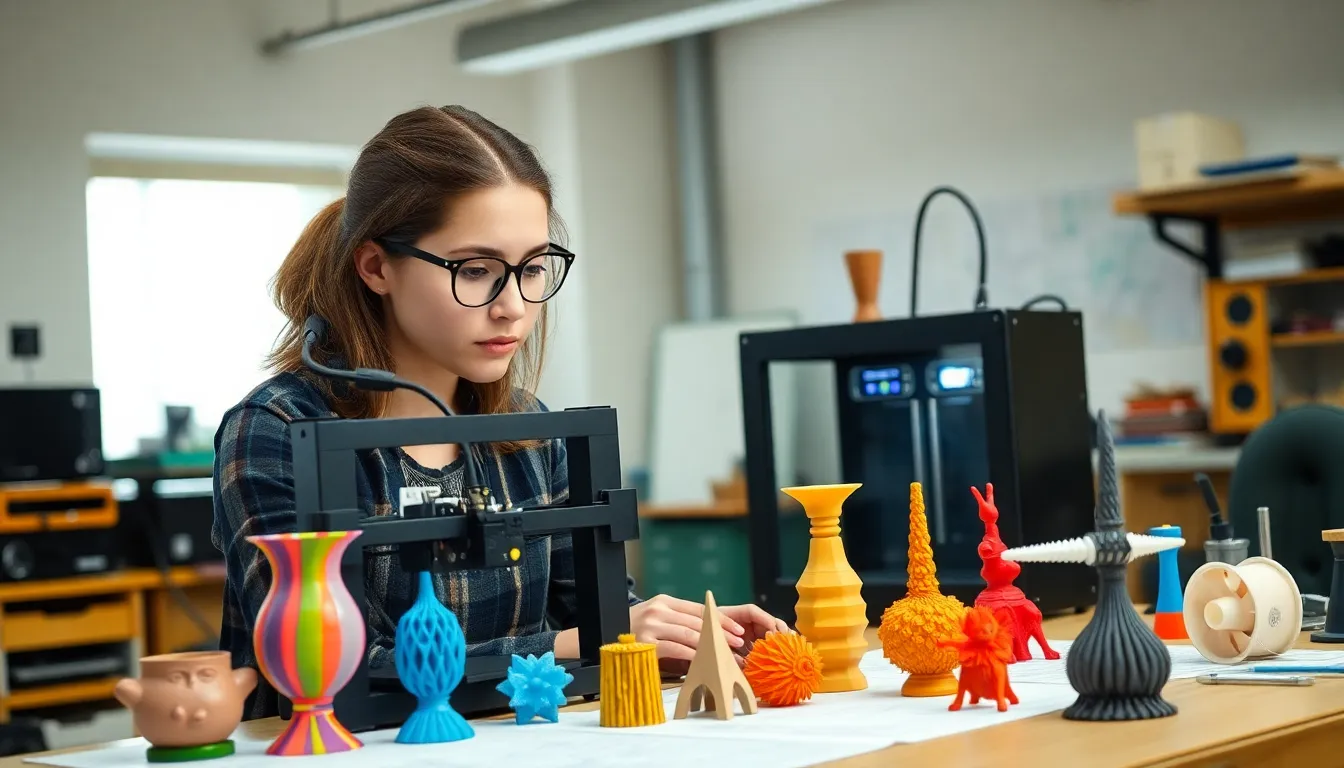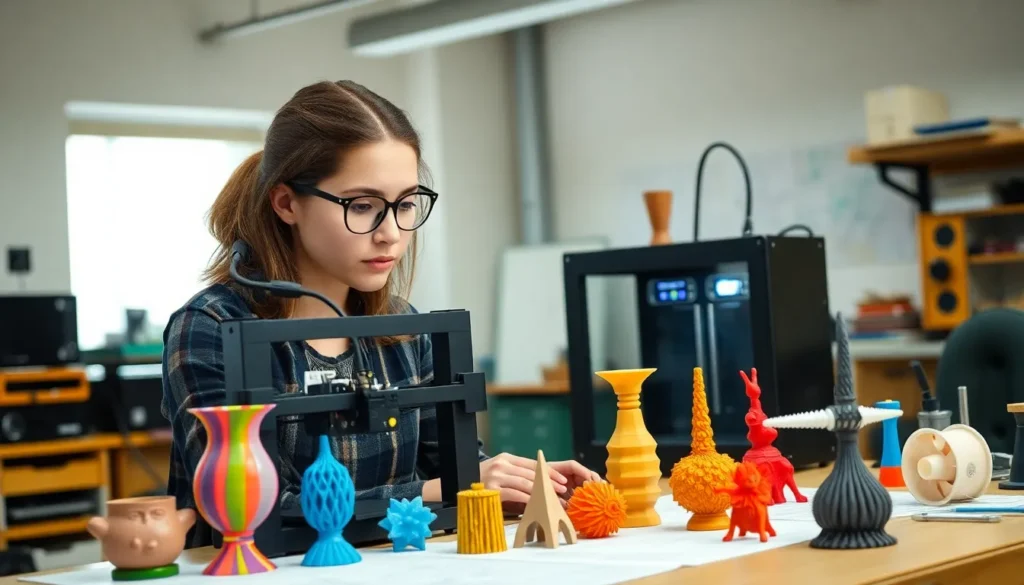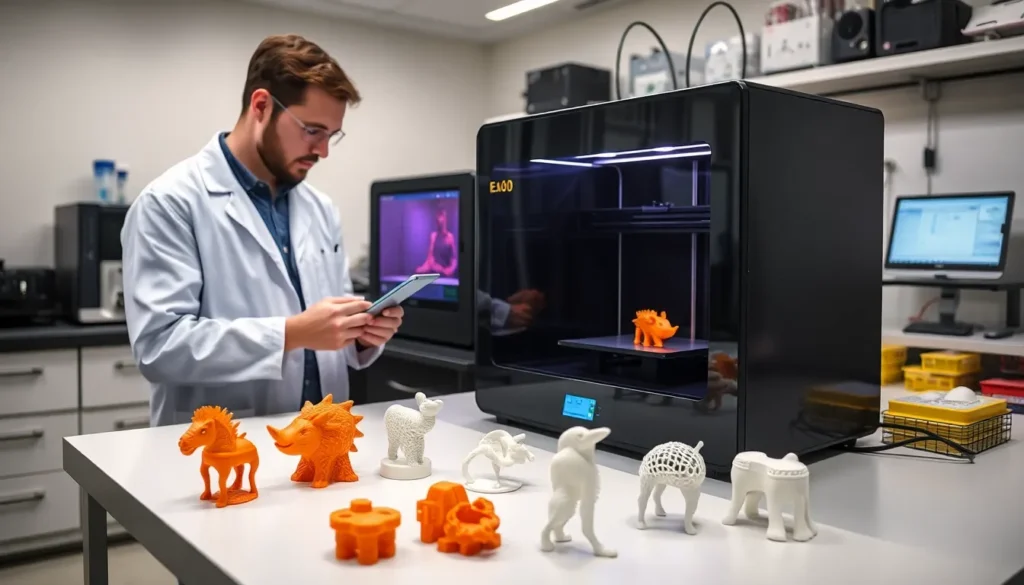In a world where imagination meets innovation, functional 3D printing materials are the superheroes of manufacturing. Forget about those flimsy plastic trinkets; these materials are here to save the day, turning wild ideas into tangible solutions faster than you can say “layer by layer.” From medical devices to custom automotive parts, they’re transforming industries and making it look easy.
Imagine crafting a complex part that not only looks good but also withstands the test of time—or at least a good coffee spill. With a range of materials that boast strength, flexibility, and even conductivity, the possibilities are endless. So buckle up as we dive into the fascinating realm of functional 3D printing materials, where creativity knows no bounds and the only limit is your imagination (and maybe your printer’s capabilities).
Table of Contents
ToggleOverview of Functional 3D Printing Materials
Functional 3D printing materials encompass a diverse range of substances designed for specific applications. These materials deliver enhanced performance traits, such as mechanical strength, thermal resistance, and electrical conductivity. Various industries utilize them, including healthcare, aerospace, and automotive.
Polymers remain a popular choice due to their versatility. While PLA offers ease of use and biodegradability, ABS provides robustness, making it ideal for functional prototypes. High-performance polymers like PEEK withstand extreme conditions, making them suitable for aerospace components.
Metals also play a crucial role in functional 3D printing. Stainless steel and titanium find applications in medical implants and aerospace parts. They offer durability, strength, and resistance to corrosion, essential for demanding environments.
Ceramic materials are gaining traction as well. They incorporate applications from dental implants to components in high-temperature environments. Their biocompatibility makes them an excellent choice for medical uses.
Conductive materials, such as graphene-infused filaments, are increasingly popular. These materials enable functions like circuit printing and electrode fabrication. As technology advances, the ability to print with conductive materials enhances design possibilities.
Overall, the evolution of functional 3D printing materials continues to reshape manufacturing paradigms. Innovators constantly explore new formulations, expanding capabilities and improving processes. The synergy between technological advancements and material science leads to more reliable, efficient, and creative solutions across various applications.
Types of Functional 3D Printing Materials
Functional 3D printing materials encompass a wide range of options designed for specialized applications, each offering unique benefits. The prevalent types include thermoplastic polymers, metals and alloys, and composites.
Thermoplastic Polymers
Thermoplastic polymers dominate the 3D printing landscape due to their versatility and ease of use. Polylactic acid (PLA) offers good strength and biodegradability, making it ideal for prototypes and educational projects. Acrylonitrile butadiene styrene (ABS) provides higher impact resistance and better thermal stability, suitable for automotive components. More advanced options like polyether ether ketone (PEEK) deliver exceptional mechanical strength and thermal resistance, specifically tailored for aerospace applications.
Metals and Alloys
Metals and alloys provide unmatched durability and strength for demanding applications. Stainless steel often finds its way into medical implants, showcasing excellent corrosion resistance and biocompatibility. Titanium, praised for its lightweight properties, becomes essential in aerospace components, where performance and reliability are critical. Tool steels combine toughness with wear resistance, serving well in manufacturing environments where precision matters.
Composites
Composites combine the best features of various materials, offering enhanced mechanical properties. Carbon fiber reinforced filaments stand out for their high strength-to-weight ratio, making them perfect for automotive and aerospace industries. Glass fiber composites deliver superior rigidity without significant weight addition, appealing to construction and infrastructure applications. Innovations in composite materials continue to expand possibilities, enhancing performance across diverse sectors.
Applications of Functional 3D Printing Materials
Functional 3D printing materials serve crucial roles across multiple industries, showcasing advanced properties that enhance various applications.
Aerospace Industry
Aerospace relies on functional 3D printing materials for lightweight, high-strength components. Engineers often use polymers like PEEK for structural parts that require thermal stability. Metal alloys such as titanium provide immense durability while reducing overall weight. These materials contribute to fuel efficiency by optimizing designs and minimizing excess mass. Advanced composites also play a significant role, combining different material properties to achieve superior performance in harsh environments.
Medical Field
The medical field benefits greatly from functional 3D printing materials, especially in producing customized implants and prosthetics. Biocompatible materials, including certain polymers and ceramics, ensure that devices integrate seamlessly with human tissues. Printing technologies enable the rapid creation of patient-specific solutions, significantly improving surgical outcomes. Furthermore, functional materials can incorporate bioactive agents to enhance healing processes. These innovations foster the development of advanced medical devices that cater to individual needs.
Automotive Sector
Automotive applications showcase the versatility of functional 3D printing materials. Manufacturers utilize thermoplastics like ABS for producing lightweight components while maintaining strength. Carbon fiber-reinforced composites are becoming standard for high-performance parts due to their excellent mechanical properties. Functional materials also support rapid prototyping, reducing time to market for new designs. Additionally, manufacturers explore conductive materials to integrate smart features into vehicles, enhancing overall functionality and user experience.
Challenges in Functional 3D Printing Materials
Functional 3D printing materials face several challenges that can impact their full potential in various applications.
Material Limitations
Many functional 3D printing materials present limitations in mechanical properties. For instance, certain polymers may lack the tensile strength required for demanding applications. Ceramics, although biocompatible, often exhibit brittleness, limiting their usability in some contexts. Metals and alloys may offer excellent durability but pose issues with weight, making them less suitable for lightweight designs. Thermal resistance also varies across materials, impacting their performance in high-temperature environments. Understanding these limitations helps researchers develop improved materials tailored for specific applications.
Processing Challenges
Processing functional 3D printing materials introduces unique difficulties. Temperature control becomes critical, as specific materials require precise thermal regulation during printing. Additionally, material viscosity can affect layer adhesion, resulting in weak points. Many composite filaments demand specialized nozzles and extruders to manage their complex compositions. The time-consuming nature of post-processing tasks, like smoothing or curing, increases production lead times. Addressing these challenges ensures higher quality outputs and more reliable performance across different industries.
Future Trends in Functional 3D Printing Materials
Innovative developments are emerging in functional 3D printing materials, enhancing their application across diverse industries. Enhanced polymers, such as bio-based and high-performance alternatives, are gaining traction due to their environmental benefits and superior properties. Researchers focus on materials with improved mechanical strength and thermal resistance, enabling more complex forms and designs.
Metal additive manufacturing continues to grow, with stainless steel and titanium leading the way. These materials are evolving, with processes for reducing production costs while maintaining superior strength and lightweight characteristics. Manufacturers are also exploring new alloy compositions that enhance ductility and overall performance for demanding applications.
Integration of smart materials signifies a significant trend in the industry. Conductive polymers and metal composites now allow the creation of parts that integrate functionalities like sensing or heating. These advancements enable manufacturers to produce components that not only function but also respond to environmental stimuli.
Sustainability remains a key concern, leading to increased use of recyclable and biodegradable materials. Innovations in bioplastics are creating possibilities for functional applications in sectors like packaging and medical devices. More companies are adopting these materials to reduce waste and environmental impact.
Collaboration across industries also plays a critical role. Partnerships between materials scientists and manufacturers lead to rapid iteration and scaling of new materials for functional printing. This synergy creates a platform for continuous improvements, ensuring that materials keep pace with the evolving demands of various sectors.
As supply chains adapt, there’s a push towards localized production using functional 3D printed materials. Reduced dependency on traditional manufacturing methods enhances responsiveness and flexibility in producing components. This shift supports on-demand manufacturing, ultimately minimizing waste and speeding up time to market.
Conclusion
The landscape of functional 3D printing materials is rapidly evolving. As industries embrace these innovative solutions, they’re unlocking new possibilities that enhance product performance and efficiency. The ongoing advancements in material science are paving the way for more versatile and sustainable options.
This evolution not only addresses current challenges but also sets the stage for future innovations. With a focus on collaboration and localized production, manufacturers are poised to meet market demands while minimizing waste. The journey of functional 3D printing materials is just beginning, and its impact on various sectors will continue to grow, driving creativity and practicality hand in hand.













